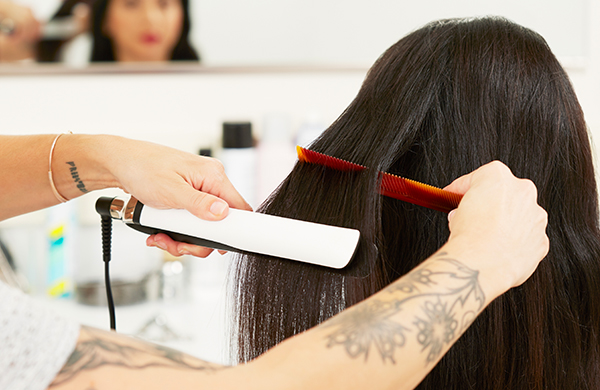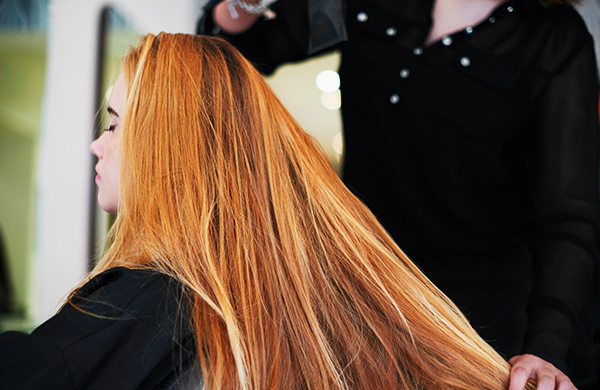
“The grass is always greener on the other side” is probably definitely a reference to women’s hair. Women with straight locks always seem to want voluminous curls, and those of us with texture wish for sleek, straight strands. And as someone whose natural hair state is ultra-frizzy and unruly, I know firsthand about wanting what we don’t have. That yen for silky, smooth locks led me to Japanese hair straightening, a type of permanent hair straightening and a way to enjoy permanently straight hair no matter how many times you wash it. Is this finally the solution to all my hair woes? Possibly, but first I want to make sure I know exactly what it entailed. Here’s what I found:
First things first, what is Japanese hair straightening?
Also known as “thermal reconditioning,” this permanent method of straightening hair traces its origins back to the ’90s in Japan, thus the region-specific name. The meticulous process transforms curly, wavy, and unruly hair into luscious, silky locks.
You’ve got my attention, so how does it work?

Although it may seem like magic, Japanese hair straightening is actually a precise science. The process physically changes the internal structure of hair by breaking down the protein bonds that give hair its unique shape and texture. Once the solution is applied to the hair, a professional-grade flat iron set to an exact temperature locks in its effects, leaving you with permanently straightened hair.
But how can I be sure Japanese hair straightening will work for me?
Before booking your appointment, a professional stylist will walk you through a detailed consultation to determine if this permanent hair straightening service is the best option for you. During this discussion, it is crucial to tell your stylist about any and all treatments you’ve had done to your hair in the past two years to prevent any adverse chemical reactions. If you’re still not convinced, the stylist can do a strand test to see how your hair will respond to the treatment.
What exactly is the styling process like?

Though it can vary in time depending on the the thickness and the length of the hair, the whole process is done in nine very precise steps that require many different chemicals, techniques, and tools.
Step 1: Fresh shampoo to make sure hair is clean and ready to go.
Step 2: A pre-treatment solution is applied to small chunks of hair at a time to protect and prepare hair for the straightening solution.
Step 3: An activator solution is applied evenly all over the hair and given time to process; the amount of time the solution is left in your hair depends on your hair’s texture. This step can take anywhere from five minutes to an hour to work.
Step 4: The activator is rinsed out and a conditioner and heat protectant are distributed throughout the hair.
Step 5: Your hair is partially blow-dried and then flat-ironed at an exact temperature to lock in the straightening solution’s effects.
Step 6: After the hair is fully straightened, a neutralizer is used to stabilize the pH balance of the hair. It will be rinsed out after about five minutes.
Step 7: A treatment conditioner that corresponds with your specific hair type is applied.
Step 8: Hair is blow-dried again, this time in the direction of the cuticles to lock in your hair’s new shape and shine.
Step 9: One last run-through with a straightening iron to ensure hair is completely straight.

Is there any upkeep once I leave the salon?
Once you leave the salon, you’re only halfway done. After-care is just as important as the actual treatment because there can still be remnants of chemical residue within the hair shaft. While your hair is settling into its new shape, it is important to keep it away from water and moisture and kinks for at least three days. That means no buns, ponytails, hats, or even tucking your hair behind your ears, or else it’ll cause a bend in your hair that won’t go away.
Does Japanese hair straightening really last forever?
It’s permanent. This process literally changes the structure of hair from the inside out, which means that treated hair won’t frizz or curl up and will remain straight as long as it’s on your head. Also beware that you’ll most likely be rocking that sleek, straight ’do exclusively because curling irons and hot rollers won’t be very effective in creating waves, volume, or curls.
As a first-timer, any tips I should know before getting it done?

Because of the intensity of the treatment, it’s extremely important to do your research on the stylist. If done incorrectly, Japanese hair straightening can wreak havoc on your hair, causing major damage and even hair loss. I asked a friend who’s been getting the treatment done for almost 10 years now and according to her, the only downside is “the awkward grow-out period where you have to wait to get your roots treated.”
Other than that, she couldn’t stop raving about her treatment, saying “it literally has changed my life, I went from spending two hours on my hair after each wash to a quick and easy wash-and-go routine. My hair dries quicker and it’s virtually frizz-free without needing any styling products. I can’t say enough good things about how it’s transformed my hair and all the time it has saved me.”





